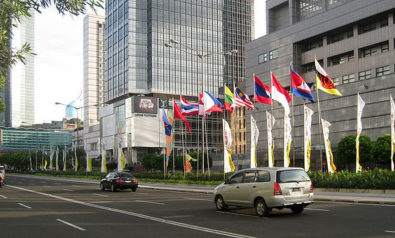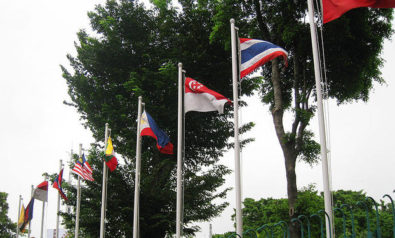The new year will see ASEAN more engaged in a balancing and hedging strategy as the “new Great Game” between the US and China in East Asia unfolds. Can ASEAN avoid being trampled underfoot? by Yang Razali Kassim A NEW “Great Game” is unfolding in East Asia as China and several Southeast Asian states make claims and counter-claims over disputed parts of the South China Sea - without any resolution. While China, as the new emergent giant in the Asia-Pacific, will increasingly insist that outside parties – meaning the United States – stay out of the region’s maritime disputes, the US is asserting its vital interest in the region by its “pivot to Asia” posture. This strategy, unveiled by President Obama in Australia just before his landmark attendance at the East Asia Summit in Bali last November, signaled a new seriousness in US intention to “return to Asia”. China’s Ambiguous Response to US Pivot Chinese rhetoric defining the “internal” nature of the South China Sea disputes is expected to become more frequent as the US steps up its engagement in the region, such as rotating a Marine force in Darwin. This is only to be expected as Washington has only recently unveiled its "pivot" to Asia - a consequence of its strategic realignment following its staggered disengagement from Iraq and Afghanistan. The growing US presence in East Asia is bound to provoke a response from China, though initially Beijing has adopted an ambiguous position. On the one hand, some Chinese officials have tended to shrug it off as a non-issue, saying the US has never left Asia to begin with. Yet, the media in Beijing, reflecting a more nationalistic view, have reacted with some alarm, seeing the pivot as directed at containing China's rise. This latter reaction is likely to reflect China's true feelings, especially amongst Chinese defence officials. China’s muted official line, however, suggests Beijing’s fear of being cast as an aggressive rising power, though China's anxiety over the American pivot is likely to grow in intensity as the US steps up its reengagement in East Asia. New Great Game - ASEAN’s role and risk This response and counter response is giving an East Asian twist to what the commentariat is increasingly referring to as the “new Great Game”. As it unfolds further ASEAN will find its diplomatic skills increasingly tested. The latest exchanges between China and the Philippines over the South China Sea is illustrative. When the Philippines Foreign Ministry protested earlier in January to the Chinese embassy over the December 2011 intrusion by a Chinese vessel into Philippines waters, Beijing’s foreign ministry spokesman responded by reiterating that “outside forces” - indirectly alluding to the US – should not meddle in regional disputes. During the Cold War, the protagonists in the old great game were the US and the Soviet Union. In the new great game, while the US is the established power, China is the new emerging giant. There is one difference, though: In the new great game, ASEAN has emerged as a significant facilitator - hedging and balancing between the two powers. The US return to Asia through the EAS lends importance to ASEAN as a central player in the East Asian region. Indeed, the formation of the EAS is yet another manifestation of ASEAN’s role as shaper and builder of the regional strategic architecture. In so doing, ASEAN has generated for itself influence far beyond what each member state could wield individually. Yet it is a delicate game not without risks. The biggest risk of balancing and hedging is the loss of balance and of being trampled underfoot as the elephants jostle for their turf. How China reacts to ASEAN’s hedging depends on how Beijing perceives ASEAN in the context of the larger US pivot to East Asia. Is ASEAN seen as the extended arm of the US to contain China? ASEAN is highly sensitive to how it is viewed by a rising China. It does not want to be dragged into China's rivalry with the US - and ASEAN has a long historical memory. As prominent Singapore strategic thinker Tommy Koh speculated, which dynasty from old China would surface in modern form to confront a future ASEAN: Would it be a Ming China, a Tang China or a Qing China? A Tang China, he said, would be benign. A Ming China would, on the contrary, be imperialistic. A Qing China would not be much different from a Ming China. China a benign power? Given the contrasting historical precedents, Prof Koh told a regional conference co-organised by RSIS in December, there is today in Southeast Asia some latent uncertainty about China: “Will China become a power that would expect others in the region to be subservient to it, as the Mings did? We want China to be like the Tang Dynasty – open, respectful of others, not like the Mings. We need to hedge our bets in case the China of the future is not China of the Tang dynasty, but China of the Qing dynasty or the Ming Dynasty. Our hope is that China will continue to be a benign power.” Prof Koh said in as much as ASEAN sees China as more benign than threatening, China should not see the US re-engagement in Asia as an attempt to contain it. ASEAN’s fundamental desire is to be friends of both and adversary to neither. It is this desire that has given birth to “ASEAN centrality” – a doctrine and mantra that was absent in the past but which is in essence a balancing and hedging strategy. The regional strategic architecture that ASEAN is constructing brick-by-brick is, however, still fragile. If it is seen as evolving, it is precisely because the region is in a state of flux, though it is clear which powers will influence its final shape. Yang Razali Kassim is a Senior Fellow with the S. Rajaratnam School of International Studies (RSIS), Nanyang Technological University and the school’s Centre for Multilateralism Studies (CMS). The views expressed in this article are the author's own and do not necessarily reflect Fair Observer’s editorial policy. *[This article was originally published by RSIS on January 17, 2012].
Support Fair Observer
We rely on your support for our independence, diversity and quality.
For more than 10 years, Fair Observer has been free, fair and independent. No billionaire owns us, no advertisers control us. We are a reader-supported nonprofit. Unlike many other publications, we keep our content free for readers regardless of where they live or whether they can afford to pay. We have no paywalls and no ads.
In the post-truth era of fake news, echo chambers and filter bubbles, we publish a plurality of perspectives from around the world. Anyone can publish with us, but everyone goes through a rigorous editorial process. So, you get fact-checked, well-reasoned content instead of noise.
We publish 2,500+ voices from 90+ countries. We also conduct education and training programs
on subjects ranging from digital media and journalism to writing and critical thinking. This
doesn’t come cheap. Servers, editors, trainers and web developers cost
money.
Please consider supporting us on a regular basis as a recurring donor or a
sustaining member.
Will you support FO’s journalism?
We rely on your support for our independence, diversity and quality.









Comment